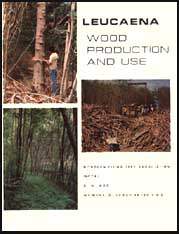Leucaena grows best in well-drained soils that are moderately alkaline (pH 7.5) to moderately acid (pH 6). These soils usually have good fertility due to adequate available calcium, magnesium, potassium, and sulfur. However, in many tropical soils phosphorous may be limiting even within the optimum pH range.
Leucaena will also grow well in strongly alkaline soils with pH greater than 7.5. These include moderately saline soils. However, minor element deficiencies of zinc, copper, or iron may occur in such soils.
Leucaena may be grown successfully in relatively acid soils, with a pH of 5.5 to 6.0, or even as low as pH 5 provided attention is given to the application of amendments like phosphorous and calcium (Figure 2-1). Some varieties of leucaena have been shown in preliminary trials to tolerate acid conditions better than others. These include the varieties Cunningham, K29, K132 and K420.
There are no varieties available at present for strongly acid soils with pH less than 5. Acid oxisols, as in tropical South America and Africa, have high levels of free aluminum and low calcium as well as low organic matter content and cation exchange capacities. This makes it difficult to grow many crops including currently available leucaena varieties. Research is underway to breed leucaena for soils of this type.
Small pilot trials of a standard leucaena variety such as K8 can indicate in a few months whether leucaena is adapted to an area. Where large scale production of leucaena is planned, such pilot trials and soil analyses are strongly recommended. Since leucaena is deep-rooted, special attention should be given to properties of the subsoil (50-200 cm depth). Especially important are soil pH, exchangeable Al and Ca levels and available phosphorus. If subsoil pH values are less than 5.0, difficulties in growing leucaena can be expected.
2-2 RAINFALL
In the humid and sub-humid tropics, rainfall usually varies from 2000 mm/yr or more down to less than 600 mm/yr. Leucaena can grow well over this range, provided soil drainage or moisture retention conditions are satisfactory. In areas where root development is not restricted by high exchangeable aluminum or low calcium and available water is plentiful in the subsoil, very good leucaena growth can be obtained even through extended dry seasons.
Leucaena growth may be severely limited by rainfall less than 600 mm/yr, particularity during the establishment period when the roots are unable to utilize available water in the subsoil. However, rainfall limitations are highly dependent on soil moisture retention capacity, the ability of roots to penetrate subsurface soil horizons, seasonal rainfall distribution and the timing of planting.
Annual rainfall of approximately 1500 mm and a four month dry season provide perhaps the best environment for leucaena production. Higher annual rainfall and even distribution of rain throughout the year may complicate harvesting and maintenance operations.
2-3 TEMPERATURE AND LIGHT
Optimum temperatures for leucaena appear to occur in the 2530° C range. Growth rates presumably relate directly to temperature. In the tropics, temperature is directly related to latitude, elevation and topography. Thus, temperature limitations to the production of leucaena may be described in terms of both elevation and distance from the equator. Generally, temperatures suitable for leucaena occur:
- Within 10° latitude of the equator, to 1000 m elevation
- Within 10-25° latitude, to 500 m elevation
In the sub-tropics, it is difficult to establish leucaena beyond 30° latitude. The frosts which occasionally occur in the subtropics do not kill leucaena unless they are severe and prolonged. Often the above-ground growth is killed, but grows back vigorously from the base as a many-branched shrub. Leucaena growth can be strongly seasonal in the sub-tropics, with low yields in the cool dry months and higher yields (2-4 times) in the hot wet season.
As a pioneer species, the growth of leucaena is greatest under high light intensities, and is greatly reduced by shading (Figure 2-2). Leucaena is thus best grown in situations in which it has maximum exposure to sunlight, i.e in newly opened clearings or as a dominant or co-dominant species in any intercrop system. While the species does not tolerate shading well, suppressed or shaded trees are slow to die and often persist for years with very little growth until the canopy is opened.
